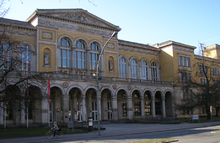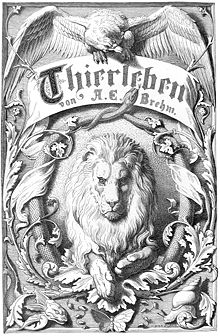Richard Heymons
Richard Heymons (born May 29, 1867 in Berlin ; † December 1, 1943 ) was a German ecologist , entomologist and zoologist and an important historical figure in the study of pentastomids ( tongue worms ).
Life

Heymons father was the publisher Carl Heymons in Berlin. Richard Heymons attended the Joachimsthal High School and studied (1886-1891) in Berlin, completed his habilitation in 1895 and initially worked as a lecturer in zoology. In 1903 he married Helene Tschuprow, who became his research assistant. Her father, Aleksandr Aleksandrovic (born February 6, 1874 - April 19, 1926) was himself a famous scholar and teacher at Moscow University (economist). With her he had two children, a daughter who died young and a son Albrecht, who went into industry as a chemist after a short, successful academic career. His dissertation was published in 1891 on the development of the sex glands of "Phyllodromica (Blatta) germanica".
From 1904 to 1906 he taught at the Royal Prussian Forest Academy in Hannoversch Münden as a full professor of zoology. In 1906 he received his professorship in Berlin. At the same time he worked as a curator of entomology at the Zoological Museum of the Friedrich Wilhelms University . In 1915 he received a chair at the Agricultural Veterinary Faculty. From 1915 to 1935 Richard Heymons was head of the zoological institute at the Agricultural University in Berlin .
Heymons published numerous publications and books, with his wife Helene Heymons providing scientific assistance. His brother, Captain Max Heymons, supplied him with insects and worms from the occupied countries ( German colonies and protected areas) for scientific purposes. He was an adjutant to Hermann von Wissmann .
At the beginning of the First World War, the Scheideanstalt in Frankfurt am Main cooperated with the entomologist Heymons in the fight against the flour moth . Heymons had already referred to the hydrogen cyanide process practiced in the USA since 1898 in 1908 . On November 18, 1916, he initiated the first large-scale experiment in the state research institute for grain processing . In a large-scale experiment, they achieved a resounding success in combating flour moths. In February 1918 Heymons received an area at a favorable lease from the management of the municipal sewage estates in Berlin-Malchow and had a private donation of 30,000 marks for the establishment of a station for research into pest control. He received great support from Erich Harnack in the endeavor to set up a research station in connection with the Agricultural University in Berlin. For this purpose, Bruno Tesch , German Society for Pest Control Berlin, chaired by Fritz Haber ( Nobel Prize for Chemistry ), was supposed to take over the coordination between industry, research and science, which had previously failed. Heymons openly spoke out in favor of continuing the research, for maintaining it even in peacetime, against purely military interests. The Senate of the Kaiser Wilhelm Society for the Advancement of Science rejected the necessary funding and such a station.
With the collaboration of his wife Helene Heymons, Heymons reworked Brehms Tierleben 1915, issue vol. 2, “The many pods, insects and spider peas”.
Richard Heymons was an honorary member of the German Entomological Society and a member of the Leopoldina in Halle and several foreign scientific societies.
Richard Heymons studied the tongue worms (Pentastomida) and his collection of these animals is in the Museum für Naturkunde in Berlin. He coined the name " Chelicerata " for arachnids and their relatives. Special attention was paid to the beetles. Some individual phenomena are named here, the bark beetle , the rape beetle , the Bashkir horse and many others, which have become indispensable in the two decades of agricultural schools.

Heymons retired in 1935. His successor in the management of the institute for agricultural zoology at the university was Hans von Lengerken.
Publications
- Monographs
- The development of the female reproductive organs of Phyllodromica (Blatta) germanica L. 1891
- About the origin of sex cells in insects . 1893
- The segmentation of the insect's body . 1895. (2010, ISBN 978-1-169-58476-1 )
- The embryonic development of Dermapteren ( earwigs ) and Orthopteren ( grasshoppers ) - with special consideration of the cotyledonous formation . 1895. (2009, ISBN 978-1-113-68513-1 )
- Basic features of the development and body structure of odonates ( odonata ) and ephemeris ( mayflies ) . 1896
- A contribution to the history of the development of the Insecta apterygota (flying insects ) . 1896
- On the morphology of the abdominal appendages in insects . 1896
- About the organization and development of Bacillus rossii ( Bacillus rossius ) Fabr . 1897
- Contributions to the morphology and development history of the rhynchotes . 1899
- Biological observations an Asian solifuge ( roller spinning ) together with contributions to the systematics of the same . 1901
- The history of the development of the scolopender ( Skolopender ) . 1901. (2011, ISBN 978-1-176-06801-8 )
- The abdomen appendages of dragonflies and their larvae . 1904
- A placenta in an insect ( hemimerus ) . 1909
- Essays
- Contribution to the systematics and morphology of tongue worms (Pentastomida) . In: Zoologischer Anzeiger , 1922, 55, pp. 154-167.
- About the dorsal organ of the pentastomids. In: Meeting reports of the Society of Friends of Natural Sciences in Berlin. 1926, pp. 22-24.
- Pentastomida. In: W. Kükenthal, T. Krumbach (Hrsg.): Handbuch der Zoologie; a natural history of the animal kingdom. 3 (1). Walter de Gruyter, Berlin 1926, pp. 69–128.
- Order: tongue worms, pentastomida (Linguatulida). In: P. Brohmer, P. Ehrmann, G. Ulmer (Hrsg.): Die Tierwelt Mitteleuropas. 3 (1). Quelle & Meyer, Leipzig 1928, p. Xx.
- Pentastomida of the German Limnological Sunda Expedition. In: Archives for Hydrobiology. 1930. Supplement Volume 3, pp. 193-198.
- A contribution to the knowledge of the pentastomids of Australia and neighboring areas. In: Journal of Parasitic Studies. 4, 1932, pp. 409-430.
- A new pentastomid from the Philippines. - Zoologischer Anzeiger 97, 1932, 295-299.
- About an abnormality in a pentastomid (Armillifer moniliformis diesing). Meeting reports of the Society of Friends of Natural Sciences in Berlin 3, 1932, 287–290.
- About the occurrence of tongue worms in birds. - Ornithological monthly reports 41, 1933, 75-76.
- with H. Graf Vitzthum: New and little known pentastomids from America. Zoologischer Anzeiger 109, 1935, 150–158.
- Pentastomida. In: Dr. HG Bronn's Classes and Orders of the Animal Kingdom. Fifth volume. IV department, 1st book. Akademische Verlagsgesellschaft, Leipzig 1935, pp. 1–268.
- with H. Graf Vitzthum: Contributions to the systematics of the pentastomids. Zeitschrift fur Parasitenkunde 8, 1936, 1–103.
- The Dr. Edm. Pentastomida collected by Dartevelle in the Belgian Congo. In: Revue de Zoologie et de Botanique Africaines. 33, 1940, pp. 122-123.
- Contributions to the systematics of the pentastomids II. Some remarkable pentastomids from Lacertilians. Zeitschrift für Parasitenkunde 10, 1939, 675-690.
- Contributions to the systematics of the pentastomids III. Pentastomids with spirally curved body shapes. Zeitschrift für Parasitenkunde 11, 1939, 77-94.
- About the way of life of the pentastomida found in crocodiles . Report of the meeting of the Society of Friends of Natural Sciences in Berlin, 1940, pp. 253–269.
- Contributions to the systematics of the Pentastomiden IV. To the knowledge of the Sambonidae . In: Zeitschrift für Parasitenkunde , 12, 1941, pp. 317–329.
- Contributions to the systematics of the pentastomids V. The type specimens of Diesingia megastoma . In: Zeitschrift für Parasitenkunde , 12, 1941, pp. 330–339.
- Contributions to the systematics of the pentastomids. VI. The species of the genus Alofia compared with Sebekia. I. Overview of the species . In: Zeitschrift für Parasitenkunde , 12, 1941, pp. 419-432.
- The dog's nose worm (Linguatula serrata Froelich), its hosts and relationships with the European animal world, its origin and practical significance based on our previous knowledge. In: Journal of Parasitic Studies. 12, 1942, pp. 607-638.
- Pentastomida. In: Institut des Parcs Nationaux du Congo Belge. Exploration du Parc National Albert. Mission GF de Witte 43, 1943, pp. 3-4.
Web links
- https://www.idref.fr/138918112
- https://www.hu-berlin.de/de/
- https://www.uni-goettingen.de/de/geschichte/71626.html
- http://www.biodiversitylibrary.org/creator/3857#/titles
- https://www.leopoldina.org/haben/en/members/member/3822/
- https://www.jstor.org/stable/41768001?seq=1
- https://peoplepill.com/people/richard-heymons/
Individual evidence
- ↑ a b Meeting reports of the Society of Friends of Natural Sciences in Berlin. New series, Volume 1, Issue 1 to 3 (1. XI. 1961), p. #.
- ↑ from the zoolog. Institute in Berlin, inaugural dissertation
- ↑ Chelicerata
- ^ The teaching collection of the Zoological Institute of the Berlin University - its history and its meaning
- ↑ a b From entomological circles. Small notes. In: Coleopterological review. 21, 1935, p. 237 ( PDF on ZOBODAT ).
| personal data | |
|---|---|
| SURNAME | Heymons, Richard |
| BRIEF DESCRIPTION | German ecologist, entomologist and zoologist |
| DATE OF BIRTH | May 29, 1867 |
| PLACE OF BIRTH | Berlin |
| DATE OF DEATH | December 1, 1943 |





